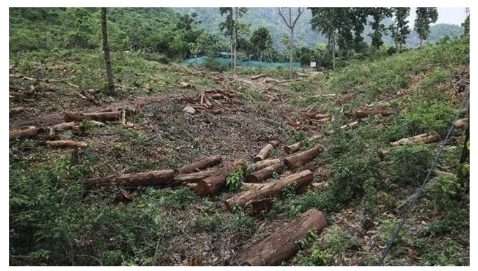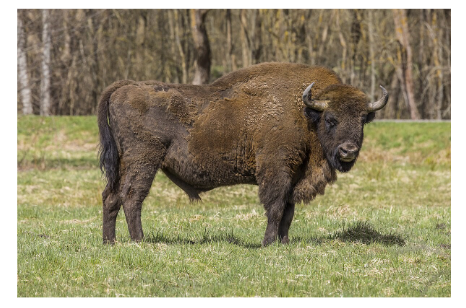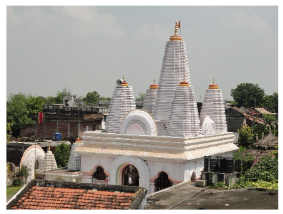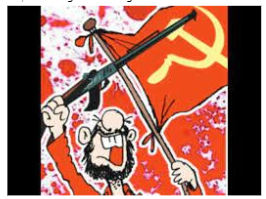Wednesday, 20th December 2023
India’s 1st Arctic Winter Expedition
In News: Raman Research Institute (RRI) is set to take part in the inaugural winter Indian expedition to the Arctic region.

India's Arctic Engagement Timeline
Early Connections
- India's association with the Arctic dates back to 1920 with the signing of the Svalbard Treaty in Paris.
- Notably, India stands among the select few nations to establish a permanent station in the Arctic, dedicated to scientific research.
- The maiden scientific expedition to the Arctic was initiated in August 2007, marking the commencement of India's consistent involvement in Arctic studies spanning both summer and winter seasons.
- Research efforts primarily concentrate on glaciology, hydrochemistry, microbiology, and atmospheric sciences.
Establishment of Research Stations and Observatories
- The Himadri research station in Ny Alesund, Svalbard, Norway, was established in July 2008, followed by the deployment of IndArc, a multisensory observatory in Kongsfjorden in 2014.
- In 2016, India further expanded its presence by establishing the northernmost atmospheric laboratory at Gruvebadet, concentrating on the study of clouds, precipitation, pollutants, and atmospheric parameters.
Arctic Council Observer Status
- India attained observer status in the Arctic Council in 2013, a position that was successfully renewed in 2019 for an additional five years.
- The Arctic Council, formed in 1996 by the eight Arctic States, serves as a pivotal intergovernmental forum fostering cooperation on shared Arctic concerns.
Introduction of Arctic Policy
- In March 2022, the Indian government unveiled its Arctic policy, outlining engagements in climate research, environmental monitoring, maritime cooperation, and energy security.
- The National Centre for Polar and Ocean Research, under the Ministry of Earth Sciences, takes charge of implementing this Arctic Policy.
Landmark Winter Expedition
- Commencing this week, India embarks on its inaugural winter expedition to the Arctic, ensuring year-round occupancy of the region.
- The Himadri research station becomes the fourth Arctic research station to be manned continuously throughout the year.
Scientific Endeavors in the Arctic
- Running from December 19, 2023, to January 15, 2024, the month-long scientific expedition is funded by the Ministry of Earth Sciences, with the National Centre for Polar and Ocean Research spearheading the initiative.
- Scientists will conduct SARAS series experiments, focusing on studying the 21-cm signal from hydrogen during the Cosmic Dawn and the Epoch of Reionization.
Significance of Arctic Studies
- The Arctic region, located above the Arctic Circle, holds significance due to its potential impact on global sea levels, atmospheric circulations, and habitability changes resulting from global warming.
- The study aims to comprehend these effects as the region becomes increasingly accessible and potentially resource-rich.
Challenges in Arctic Expeditions
- Arctic expeditions pose challenges due to the extreme environment, with limited opportunities for scientific observations and sampling, particularly during the harsh winter months.
- Only three research stations have maintained year-round staff deployment so far.
- Geopolitical tensions, exemplified by the Ukraine-Russia conflict, also pose potential hindrances to Arctic explorations.
Global Players in Arctic Research
- Since 1990, Ny-Ålesund in Svalbard has hosted research stations from ten countries, including China, Germany, France, India, Italy, Japan, Netherlands, Norway, South Korea, and the United Kingdom.
- While eleven permanent research stations exist, only three maintain human presence throughout the year, highlighting the challenges and competitive dynamics in Arctic research.
Source: TH
Procedure for the Suspension of Members of Parliament
In News: In a significant heightening of tensions between the Opposition and the government, 78 Members of Parliament faced suspension from both Houses of Parliament.

Grounds for Suspending MPs in Lok Sabha
- Preserving Order in House Proceedings
- The fundamental responsibility of maintaining order in the Lok Sabha lies with the Presiding Officer, namely the Speaker.
- Rule 373 of the Rules of Procedure and Conduct of Business grants the Speaker authority to instruct a member to immediately withdraw from the House if their conduct is deemed grossly disorderly.
- Directive to Withdraw and Suspension
- Under Rule 373, if the Speaker finds a Member's conduct grossly disorderly, the Member is directed to withdraw immediately and must remain absent for the rest of the day's sitting.
- Rule 374 empowers the Speaker to name a Member who disregards the authority of the Chair or persistently obstructs the House's business.
- Subsequently, a motion may be put forth to suspend the named Member for a period not exceeding the remainder of the session.
Suspension Protocol in Rajya Sabha
- Role of the Chairperson in Rajya Sabha
- Unlike the Lok Sabha, the Chairperson of the Rajya Sabha lacks the unilateral power to suspend a member.
- Rule 256 governs the suspension process in the Rajya Sabha, where the Chair can only suspend a member through a motion.
- Naming and Suspension Motion
- In the Rajya Sabha, the Chairperson names a member for disorderly conduct, initiating a motion for suspension.
- Rule 256(2) stipulates that the House may suspend the named member for a duration not exceeding the remaining session.
- Chair's Authority to Direct Withdrawal
- While the Chairperson cannot independently suspend a member, Rule 255 empowers them to direct the immediate withdrawal of any member whose conduct is perceived as grossly disorderly.
- The ordered member must withdraw promptly and remain absent for the rest of the day's meeting.
Recent Developments: Unprecedented MP Suspensions
- Escalation in Tensions
- In a significant development amplifying tensions between the Opposition and the government, 78 Members of Parliament faced suspension from both Houses of Parliament.
- Unprecedented Numbers
- This suspension raised the total number of MPs suspended in the current session to 92, marking an unprecedented occurrence in the history of the Indian Parliament.
- Opposition leaders decried the situation as a "murder of democracy."
- Suspension Resolution
- The Minister for Parliamentary Affairs, Pralhad Joshi, presented a resolution for the suspension of 33 MPs, which was passed by a voice vote.
- Thirty MPs in the Lok Sabha were suspended for the Winter Session, while three faced suspension pending the Privileges Committee's report for climbing onto the Speaker's podium to raise slogans.
- Protest Context: Security Breach and Demands
- Protesting Opposition MPs in both the Lok Sabha and the Rajya Sabha sought a statement from the Home Minister regarding the recent security breach in the Lok Sabha, resulting in the arrest of six individuals.
Source: TH
Telecom Bill 2023 - Edukemy Current Affairs
In News: The Union Minister for Communications, Electronics & Information Technology presented the Telecommunications Bill, 2023 in the Lok Sabha.

Rationale for Introducing the Telecommunications Bill, 2023
- Crucial Role of Telecommunications
- The telecommunications sector, acting as a catalyst for economic and social progress, serves as the primary gateway to digital services, playing a pivotal role in the nation's development.
- Recognizing its significance, the security of the country is inherently tied to the safety of its telecommunication networks.
- Hence, the imperative to establish a legal and regulatory framework that prioritizes secure and robust telecommunication networks, fostering digitally inclusive growth.
- Evolution of Telecommunications and Legislative Need
- Given the substantial transformations in the nature, usage, and technologies underlying telecommunications, particularly in the past decade, there arises a pressing need for legislation that aligns with the evolving demands of society.
Key Provisions of the Telecommunications Bill, 2023
- Revocation of Existing Laws
- The bill abolishes the Indian Telegraph Act, 1885, the Indian Wireless Telegraphy Act, 1933, and the Telegraph Wires (Unlawful Possession) Act, 1950, while introducing amendments to the Telecom Regulatory Authority of India (TRAI) Act, 1997.
- Centralized Authorization for Telecom Activities
- To provide telecommunication services, establish, operate, maintain, or expand telecommunication networks, or possess radio equipment, prior authorization from the central government becomes mandatory.
- Existing licenses remain valid for their granted period or five years if unspecified.
- Spectrum Assignment and Allocation
- Spectrum allocation occurs through auctions, with exceptions for specific uses such as national security, disaster management, weather forecasting, and essential services.
- The central government holds the authority to re-purpose or re-assign frequency ranges.
- Interception and Search Powers
- The bill grants powers to intercept, monitor, or block messages between individuals under specified grounds, emphasizing public safety, emergencies, security, prevention of offenses, or public order.
- Government's Extraordinary Powers
- In instances of public emergency or safety concerns, the government may temporarily take possession of telecom infrastructure, suspend telecom services, and conduct searches for unauthorized telecom networks or equipment.
- Standards Specification Authority
- The central government is empowered to prescribe standards and assessments for telecom equipment, infrastructure, networks, and services.
- Right of Way for Telecom Infrastructure
- Facility providers can seek a right of way over public or private property to establish telecom infrastructure, emphasizing non-discrimination and non-exclusivity.
- User Protection Measures
- The central government is authorized to implement measures safeguarding users, including consent for receiving specified messages, creation of Do Not Disturb registers, and mechanisms to report malware or specified messages.
- TRAI Appointments
- Amendments to the TRAI Act allow individuals with a minimum of 30 years of professional experience to serve as the chairperson and at least 25 years for members.
- Digital Bharat Nidhi
- Retaining the Universal Service Obligation Fund (USOF) under the 1885 Act, the bill renames it as Digital Bharat Nidhi and expands its use to include research and development (R&D).
- Adjudication Process
- The central government appoints an adjudicating officer, ranked joint secretary and above, to conduct inquiries and issue orders against civil offenses.
- Appeals against orders can be made to the Designated Appeals Committee and further to TDSAT.
- Offenses and Penalties
- The bill outlines criminal and civil offenses, including imprisonment, fines, and penalties for providing unauthorized telecom services, breaching terms and conditions, and possessing unauthorized equipment or using unauthorized networks or services.
Explaining TDSAT and TRAI
- Telecom Disputes Settlement and Appellate Tribunal (TDSAT)
- Established in 2000, TDSAT resolves disputes and appeals in the Indian telecommunications sector, aiming to safeguard the interests of consumers and service providers, ensuring the sector's orderly growth.
- Telecom Regulatory Authority of India (TRAI)
- TRAI is a government regulatory body established to oversee the telecommunications sector in India, with a mission to create conditions conducive to the growth of telecommunications in the country.
Source: IE
The Indian Forest and Wood Certification Scheme (IFWCS)
In News: In response to increasing global apprehensions regarding deforestation and the illegal trade of timber, the Indian government has introduced its national forest certification initiative, titled The Indian Forest and Wood Certification Scheme (IFWCS).

Understanding the Indian Forest and Wood Certification Scheme (IFWCS)

Scope of IFWCS Certification
IFWCS provides certification for three main aspects:
- Sustainable Forest Management
- Ensuring responsible and sustainable practices in forest management.
- Management of Trees Outside Forests
- Extending certification to cover trees in plantations and areas outside traditional forests.
- Chain of Custody
- Offering a guarantee of traceability throughout the supply chain, from the origin of a forest product to its presence in the market.
Potential Beneficiaries of Certification
IFWCS certification can be beneficial for various stakeholders:
- Forest Management Units
- Entities responsible for overseeing and managing forest areas.
- Corporations and Wood-Based Industries
- Businesses involved in wood processing and related industries.
- Tree Growers and Traders
- Individuals or entities engaged in cultivating trees or trading timber and Non-Timber Forest Produce (NTFP).
- Saw Millers, Exporters, and Importers
- Entities involved in the processing, export, and import of wood-based and NTFP-based products.
- End-User Industries
- Industries utilizing forest products in their manufacturing processes.
Forest Management in India: Adherence to Standards
- Forests in India are managed based on individual working plans, updated to align with the Indian Forest Management Standards.
- These standards comprise 8 criteria, 69 indicators, and 254 verifiers, setting mandatory guidelines for all forest divisions in the country.
- While obtaining IFWCS certification is not compulsory for forest divisions, adherence to these standards makes them eligible.
- Certification is contingent on the specific needs and goals of each division.
Motivation Behind IFWCS
- The need for IFWCS arises from global concerns regarding deforestation and questions surrounding the credibility of existing forest certifications.
- Previous investigations by the International Consortium of Investigative Journalists (ICIJ) raised doubts about the integrity of such certifications, impacting the acceptance of Indian products in international markets.
- Given tightening regulations in major export markets like Europe and the US, the IFWCS addresses the necessity for a more regulated market.
- The initiative aligns with global commitments, including the pledge at the Glasgow climate change conference in 2021 to halt and reverse deforestation by 2030.
Significance of IFWCS
- Alternative to Foreign Certification Agencies
- IFWCS provides a domestic alternative to private foreign certification agencies operating in the Indian market for the past two decades.
- Enhanced Trust and Transparency
- The scheme brings increased trust and transparency to processes, contributing to the broader acceptance of Indian forest-based products in international markets.
- Government-Backed Initiative
- Although currently initiated and supported by the government, IFWCS is anticipated to evolve into an independent entity similar to the Bureau of Indian Standards (BIS) or Quality Council of India (QCI) in the future.
Source: IE
District Mineral Foundation (DMF)
In News: The Minister of Coal and Mines stated that the District Mineral Foundation (DMF) has been established across 644 districts in 23 states.

About District Mineral Foundation (DMF)
The District Mineral Foundation (DMF) functions as a non-profit trust established under the Mines and Minerals (Development and Regulation) (MMDR) Amendment Act 2015.
- Objective
- The primary goal of the DMF is to serve the interests and welfare of individuals and areas affected by mining-related activities, as determined by the respective State Government.
- Financing
- Funding for the DMF is sourced from contributions made by holders of major or minor mineral concessions in the district, following guidelines set by the Central or State Government.
- Jurisdiction
- The operations of DMFs fall within the purview of the relevant State Government.
- The composition and responsibilities of the District Mineral Foundation are defined in accordance with regulations stipulated by the State Government.
- Fund Collection
- The collection of funds for the DMF occurs at the district level.
Essential Information about Pradhan Mantri Khanij Kshetra Kalyan Yojana (PMKKKY)
The Ministry of Mines introduced PMKKKY in 2015 with the aim of promoting the well-being of regions and individuals impacted by mining activities, utilizing funds generated by District Mineral Foundations (DMFs).
- Objectives
- To execute various developmental and welfare projects in mining-affected areas, aligning with existing schemes of the State and Central Government.
- To minimize and mitigate adverse impacts on the environment, health, and socio-economic aspects of people in mining districts during and after mining operations.
- To ensure sustainable long-term livelihoods for affected individuals in mining areas.
- Implementation
- PMKKKY is implemented by the DMFs of respective districts, utilizing funds accrued to the DMF as mandated by the Mines and Minerals (Development and Regulation) Amendment Act, 2015.
- The Central Government has specified contribution rates payable by miners to the DMFs.
- For mining leases executed before January 12, 2015, miners must contribute 30% of the royalty payable.
- For leases granted after this date, the contribution rate is set at 10% of the royalty payable.
- PMKKKY is implemented by the DMFs of respective districts, utilizing funds accrued to the DMF as mandated by the Mines and Minerals (Development and Regulation) Amendment Act, 2015.
- Utilization of Funds
- High Priority Areas (Minimum 60%)
- Allocation of at least 60% of PMKKKY funds for critical sectors like drinking water supply, healthcare, education, and environmental preservation.
- Other Priority Areas (Maximum 40%)
- Utilization of up to 40% of PMKKKY funds for additional priority areas, including physical infrastructure, irrigation, energy, and watershed development, among others.
- High Priority Areas (Minimum 60%)
|
UPSC Previous Year Questions Prelims (2016) Q. What is/are the purpose/purposes of ‘District Mineral Foundations’ in India?
Select the correct answer using the code given below: (a) 1 and 2 only Ans: (b) |
Source: DD
The Wisent: European Bison - Edukemy Current Affairs
In News: The continuing conflict in Ukraine has had a negative impact on endeavors to conserve the wisent, commonly known as the European wood bison.

Wisent (European Wood Bison): An Overview
- Overview
- The European wood bison (Bison bonasus) holds the distinction of being the largest and heaviest terrestrial mammal in Europe.
- Subspecies Extinction
- Originally consisting of three subspecies, only one, Bison bonasus bonasus, has survived, as the other two faced extinction.
- Habitat
- Thriving in grasslands, deciduous, and mixed forests, the wisent stands out for its role as an ecosystem engineer, playing a pivotal role in the restoration of grassland habitats.
- Distribution
- The wisent's range encompasses Belarus, Lithuania, Poland, the Russian Federation, Slovakia, and Ukraine.
- IUCN Red List Status
- Listed as Near Threatened on the IUCN Red List, the wisent faces conservation concerns.
- Threats
- The historical extirpation of the wisent across Europe can be attributed to the combined pressures of rapid environmental changes and human-induced hunting.
|
UPSC Previous Year Questions Prelims (2023) Q. ‘Invasive Species Specialist Group’ (that develops Global Invasive Species Database) belongs to which one of the following organizations? (a) The International Union for Conservation of Nature Ans: (a) Exp:
|
Source: DTE
SATHEE Portal - Edukemy Current Affairs
In News: The Minister of State for Education, in a Lok Sabha response, revealed the initiation of the SATHEE portal by the Department of Higher Education, Ministry of Education, in collaboration with IIT Kanpur.

About SATHEE Portal
The portal aims to offer high-quality education to all students aspiring for competitive exams like JEE, NEET, and State-level engineering exams, and to aid JEE preparation, a 45-day crash course has been introduced, curated by IIT toppers, academicians, and subject experts, available in five languages, facilitated by an AI-based translation tool developed by the All India Council of Technical Education (AICTE), supporting 22 Indian languages.
Source: PIB
Yogmaya Temple - Edukemy Current Affairs
In News: The Yogmaya Temple, considered historically significant, is believed to stand on the site of an ancient temple dating back to the Mahabharata era.

Yogmaya Temple Overview
- Location and Name
- Situated near the renowned Qutub Minar in Mehrauli (Delhi), the Yogmaya Temple, also known as Jogmaya Temple, is an ancient Hindu shrine.
- Construction and Patronage
- Built between 1806 and 1837 by Lala Sidhu Mal, a noble in the court of Mughal Emperor Akbar II, the temple has historical roots in the area known as Yoginipura in ancient Jain texts. Prithviraj Chauhan is believed to have patronized a Yogini temple here.
- Significance
- A focal point during Akbar II's rule, the temple features a replica of the Goddess Yogmaya, also referred to as the "Pure Goddess."
- Unique Festival
- The temple is renowned for the exclusive celebration of the 'Phoolwalon ki Sair' festival.
Qutb Minar Key Facts
- Architecture and Construction
- Constructed in red and buff sandstone, the Qutb Minar stands as the tallest tower in India.
- Qutbu'd-Din Aibak initiated its foundation in AD 1199, and subsequent storeys were added by his successor and son-in-law, Shamsu'd-Din Iltutmish (AD 1211-36).
- Design Features
- Each storey of the minar is surrounded by a projected balcony supported by stone brackets, adorned with a honey-comb design, prominently featured in the first storey.
Source: IE
Sultanpur National Park - Edukemy Current Affairs
In News: Forest department officials have indicated that Sultanpur National Park in Farrukhnagar, Gurugram, has witnessed a reduction of 20-30 percent in the count of migratory birds this season.

Sultanpur National Park Overview
Formerly known as Sultanpur Bird Sanctuary, Sultanpur National Park is situated in the Gurgaon district of Haryana and primarily comprises wetlands.
- Habitat and Designation
- This national park serves as a crucial habitat for aquatic birds, encompassing both migratory and resident species.
- In 2021, it attained recognition as a Ramsar site, signifying its status as a wetland of international importance.
- Vegetation
- The park features tropical and dry deciduous vegetation, seasonal aquatic plants, and artificial islands, along with open grasslands.
- Flora
- Diverse flora includes grasses, dhok, khair, tendu, ber, jamun, banyan trees, and neem.
- Fauna
- Sultanpur National Park is a significant wintering ground for waterfowl.
- Among the bird species present are the Common hoopoe, Purple sunbird, Black francolin, Little cormorant, Indian Cormorant, Siberian Crane, Greater Flamingo, Common Teal, Common Greenshank, Ruff, and more.
Source: IE
Chum salmon - Edukemy Current Affairs
In News: In a recent finding, scientists have uncovered that Chum salmon, a migratory fish species, has been engaging in spawning activities in Arctic waters.

Chum Salmon Overview
- Chum salmon, also referred to as dog salmon, is a species of anadromous salmonid fish, characterized by hatching in freshwater streams and rivers and subsequent migration to the ocean for feeding and growth.
- Unlike residing in freshwater for an extended period, they undertake a lifecycle that includes both freshwater and saltwater environments.
- Distribution
- As the most widely distributed among Pacific salmon, Chum salmon are found extensively in the North Pacific Ocean.
- Their range spans from the Arctic coast of Canada throughout the northern coastal regions of North America and Asia.
- Habitat
- During their early stages, these salmon inhabit freshwater streams, estuaries, and associated wetlands for growth and feeding.
- Subsequently, they spend the remaining part of their life foraging in the ocean before returning to the streams and tributaries of their origin for spawning.
Source: WION
Revealing Left Wing Extremism in India
In News: Recently an article contends that effective implementation of PESA can empower tribal communities to engage in the planning and execution of development initiatives, promote social justice, and safeguard their rights and resources.

Understanding Left Wing Extremism in India
- Introduction
- Left-wing extremism, characterized by radical ideologies and revolutionary means, traces its origin to the 1967 Naxalbari uprising in West Bengal.
- This phenomenon affects 90 districts in 10 states, with varying degrees of impact.
Factors Behind Left Wing Extremism
- Inequitable Development
- LWE areas suffer from high poverty, unemployment, illiteracy, malnutrition, and social exclusion.
- Exploitation of grievances among marginalized communities, especially tribals, deprived of land and resources.
- Governance Deficit
- Weak, corrupt, or absent governance in LWE areas creates a vacuum filled by extremist groups.
- Disruption of democratic processes through violence and intimidation.
- Ideological Appeal
- LWE groups reject parliamentary democracy, advocating armed revolution.
- Draw inspiration from Mao Zedong and the Naxalbari uprising.
- Globalization and Cultural Displacement
- Globalization's impacts contribute to dislocation and alienation.
- LWE movements provide identity and purpose amid cultural changes
Government Initiatives
- Security Measures
- Deployment of Central Armed Police Forces (CAPFs).
- Strengthening state police and establishing specialized units.
- Development Initiatives
- Integrated projects for infrastructure, livelihood, and basic needs.
- Skill development and sustainable livelihood programs.
- Ensuring Rights and Entitlements
- Addressing land and forest rights through legislation.
- Grievance redressal mechanisms and empowerment of local communities.
- Other Measures
- Civic Action Program (CAP) for community engagement.
- Surrender and Rehabilitation Policy.
- SMART Police strategy for data-driven policing.
Impact of Measures
Significant reduction in LWE violence and geographical spread over the past eight years.
Future Recommendations
- Effective Implementation of PESA Act
- Ensure complete PESA implementation.
- Address gaps exploited by Maoists.
- Tribal Empowerment and Representation
- Increase tribal representation in local governance.
- Acknowledge and address tribal aspirations.
- Development Programs
- Implement targeted socio-economic development programs.
- Ensure participatory development initiatives.
- Counter Maoist Propaganda
- Launch communication strategies to counter propaganda.
- Collaborate with local media and influencers.
- Negotiation and Conflict Resolution
- Explore peaceful negotiation with moderate factions.
- Involve neutral mediators in peacebuilding.
- Human Rights Protection
- Ensure protection of human rights in conflict zones.
- Minimize collateral damage and civilian casualties.
- Long-term Strategic Planning
- Develop a comprehensive, long-term strategy for sustainable development.
- Focus on social justice and inclusive governance.
Conclusion
Government efforts, including security measures and development initiatives, show progress in curbing Left-wing extremism. Continued strategic planning and addressing root causes are crucial for lasting eradication.
|
UPSC Previous Year Questions Mains (2020) Q. What are the determinants of left-wing extremism in Eastern part of India? What strategy should the Government of India, civil administration and security forces adopt to counter the threat in the affected areas? Mains (2015) Q. The persisting drives of the government for development of large industries in backward areas have resulted in isolating the tribal population and the farmers who face multiple displacements. With Malkangiri and Naxalbari foci, discuss the corrective strategies needed to win the Left-Wing Extremism (LWE) doctrine that affected citizens back into the mainstream of social and economic growth. |
Source: TH
Share the article
Edukemy’s Current Affairs Quiz is published with multiple choice questions for UPSC exams
MCQ
Get Latest Updates on Offers, Event dates, and free Mentorship sessions.

Get in touch with our Expert Academic Counsellors 👋
FAQs
UPSC Daily Current Affairs focuses on learning current events on a daily basis. An aspirant needs to study regular and updated information about current events, news, and relevant topics that are important for UPSC aspirants. It covers national and international affairs, government policies, socio-economic issues, science and technology advancements, and more.
UPSC Daily Current Affairs provides aspirants with a concise and comprehensive overview of the latest happenings and developments across various fields. It helps aspirants stay updated with current affairs and provides them with valuable insights and analysis, which are essential for answering questions in the UPSC examinations. It enhances their knowledge, analytical skills, and ability to connect current affairs with the UPSC syllabus.
UPSC Daily Current Affairs covers a wide range of topics, including politics, economics, science and technology, environment, social issues, governance, international relations, and more. It offers news summaries, in-depth analyses, editorials, opinion pieces, and relevant study materials. It also provides practice questions and quizzes to help aspirants test their understanding of current affairs.
Edukemy's UPSC Daily Current Affairs can be accessed through:
- UPSC Daily Current Affairs can be accessed through Current Affairs tab at the top of the Main Page of Edukemy.
- Edukemy Mobile app: The Daily Current Affairs can also be access through Edukemy Mobile App.
- Social media: Follow Edukemy’s official social media accounts or pages that provide UPSC Daily Current Affairs updates, including Facebook, Twitter, or Telegram channels.





